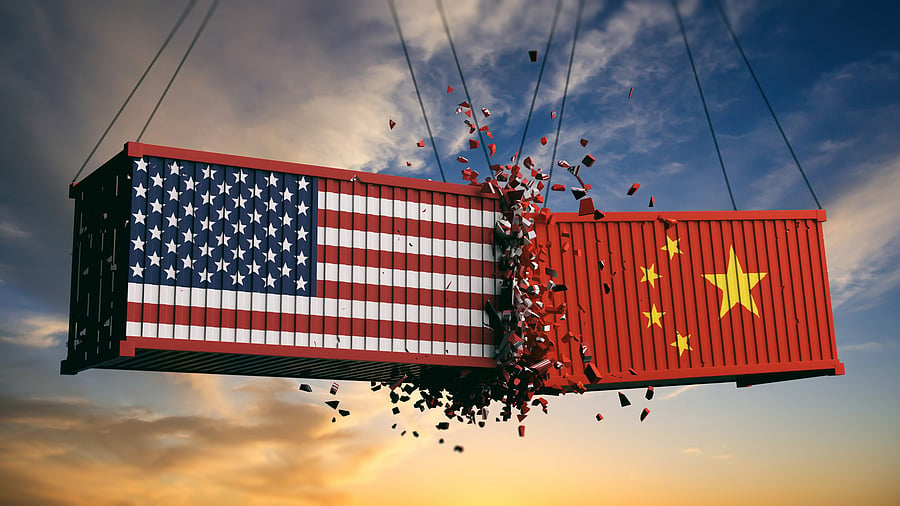
Image for representation.
Credit: iStock Photo
By Andy Mukherjee
The optimism around President Donald Trump’s promise of a “total reset” in relations with Beijing is fading fast; and that’s a worrying omen for US importers. For many, the urgency to look outside China for new suppliers is greater than it was during Trump 1.0.
The peak US tariff on Chinese goods during Trump’s first term was 21 per cent; it is 51 per cent now. Besides, there was a workaround back then. A lot of Chinese-made consumer goods entered America via an exemption from tariffs for parcels below $800 in value.
That cushioned the blow. The actual drop in imports from the People’s Republic may have been a lot lower than the 17 per cent plunge captured in the 2019 US statistics. In the present conflict, though, even small-value items shipped from China or Hong Kong are being taxed at 54 per cent. While that’s down from the 120 per cent tariff at the peak of trade hostility, the May 12 truce is looking wobbly, with Trump accusing Beijing of violating its terms.
The trade talks between the two governments are “a bit stalled,” according to Treasury Secretary Scott Bessent. Meanwhile, new tensions have emerged over the administration’s decision to start revoking Chinese student visas and introduce new restrictions on the sales of chip design software. If they haven’t already done so, now is the time for importers to call their bankers.
A certain kind of lender can be an useful ally during a trade war, as a new study by Harvard University professor Laura Alfaro, together with economists from the Federal Reserve Bank of Atlanta and the International Monetary Fund, shows. Tracking supplier relationships with maritime trade data, and mapping them against corporate loan information that banks report to the Fed, the researchers estimate that an average US importer, facing Trump’s 2018-19 tariffs, shelled out $1.9 million — or 5 per cent of annual sales — to get matched to a new Asian supplier.
The expensive process forced importers to draw down on existing credit lines and take out new loans. This is where US lenders with expertise in Asian trade finance were of help. “Tariff-hit firms with specialized banks borrowed at lower rates and were 15 percentage points more likely and three months faster to establish new supplier relationships than firms with other banks,” the authors conclude. In other words, those importers that had access to trade-finance specialists benefited not only from cheaper credit, but also from information about supplier networks.
Alfaro and her colleagues don’t say which banks did the heavy lifting. The Fed’s corporate loan data, known as Y14, is not in the public domain. But it’s not hard to make an educated guess. Citigroup Inc., JPMorgan Chase & Co., Bank of America Corp., and their British and European peers, such as HSBC Holdings Plc, Standard Chartered Plc, and BNP Paribas SA, have long histories of financing international trade. In Asian banking circles, some of them are known as “glocals,” or global banks with sophisticated local knowledge. The experience they have gained by financing the region’s exports is both valuable and specific. As Alfaro’s study shows, “relationships with banks specialized in Europe (not Asia) have no effect on credit or trade outcomes for firms searching for suppliers in Asia.”
Now, more than ever, US importers need to be mindful of their banks’ geographical footprint, even though the uncertainty around where to search for new partners is large enough to cripple decision-making.
Five years ago, China bore the brunt of customs duties; American taxes on the rest of the world were a manageable 3 per cent. They’re approaching 16 per cent now. The threat of much larger reciprocal tariffs is looming over both rivals and allies. The electronics supply chain is fearful because the president has vowed punitive duties on Apple Inc. and Samsung Electronics Co. if they assembled devices sold in the US anywhere overseas — not just China. The auto industry is caught up in Beijing’s export restrictions on rare-earth magnets, a tit-for-tat against Trump’s tariffs.
Still, business owners can’t sit idle. Even if the current magnet crunch ends soon, they still have to explore Malaysia and India as potential alternatives — just in case the truce between Washington and Beijing collapses. Vietnamese and Cambodian factories may expand to fill orders for everything from Nike Inc. shoes to Lululemon Athletica Inc. clothing.
In markets where trade-finance specialists don’t have a presence, they acquire knowledge about local firms via a so-called network effect. According to Alfaro and her colleagues, borrowers have a higher chance of being matched with suppliers in countries where their lenders have correspondent-banking arrangements — or have previously participated in syndicated loan deals.
Trade finance is not just about lubricating cross-border commerce with money; it’s also about keeping business intelligence flowing. For importers caught up in a tumultuous global conflict, a call to the banker is a good starting point.